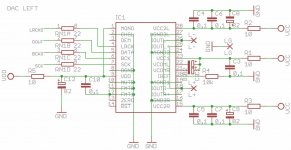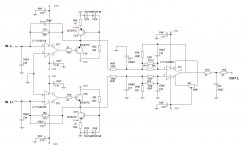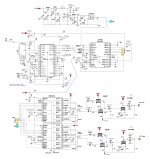That was jcx, not me so I'll leave him to answer. I agree with his view though.
Sorry, got a little confused there
I'll just route the resistors topside and easily removable on the prototype board, and see what happens. Sadly, I have no scope or other measuring equipment, so all I can rely on is my ears.
I can't find any DIT jitter info on AK4114 or 4115, but I'll just try both with and without SRC and see if there's any difference. Or just screw it and tell myself it's good enough without SRC...
if you put 1206 chip R pattern in series supply position you can always try ferrite bead core lossy inductors too - 0805 fit 1206 lands good enough for hand assembly so either could be used
I'd be frightened to think someone without a 'scope would tackle the Hawksford nested multiloop op amp I/V - its not a established diy project with any history - lots of possible bugs, parts selection subtleties, MHz oscillation to check for - even if layed out properly
I'd be frightened to think someone without a 'scope would tackle the Hawksford nested multiloop op amp I/V - its not a established diy project with any history - lots of possible bugs, parts selection subtleties, MHz oscillation to check for - even if layed out properly
Sorry, got a little confused there
I'll just route the resistors topside and easily removable on the prototype board, and see what happens. Sadly, I have no scope or other measuring equipment, so all I can rely on is my ears.
I can't find any DIT jitter info on AK4114 or 4115, but I'll just try both with and without SRC and see if there's any difference. Or just screw it and tell myself it's good enough without SRC...
You_really_need_a_scope_and_some_other_test_ equipment!
Ears are insufficient in the digital realm.. You can pick up a working scope on eBay or a local hamfest (ham radio electronic flea market) for relatively little money. A good DVM or two, and a decent function generator, audio generator will stand you in good stead..
A friend of mine picked up a working Tek 2245A for $20 at the MIT radio club hamfest a week ago..
Last edited:
We're a little short on hamfests in Norway, I'm afraid 
I know this goes against the DIY spirit, but I'm not sure I want to venture into the world of scopes. There's simply too much learning and experience involved for me to enjoy it on a hobby level. And inductors are another design aspect I really don't want to have to learn, but some simple suggestions are welcome. Russ White uses CLC (10uF > unknown L > 0.1uF) on each rail on the 1794 in his COD, which afaik is pretty good.
I know this goes against the DIY spirit, but I'm not sure I want to venture into the world of scopes. There's simply too much learning and experience involved for me to enjoy it on a hobby level. And inductors are another design aspect I really don't want to have to learn, but some simple suggestions are welcome. Russ White uses CLC (10uF > unknown L > 0.1uF) on each rail on the 1794 in his COD, which afaik is pretty good.
Last edited:
We're a little short on hamfests in Norway, I'm afraid
I know this goes against the DIY spirit, but I'm not sure I want to venture into the world of scopes. There's simply too much learning and experience involved for me to enjoy it on a hobby level. And inductors are another design aspect I really don't want to have to learn, but some simple suggestions are welcome. Russ White uses CLC (10uF > unknown L > 0.1uF) on each rail on the 1794 in his COD, which afaik is pretty good.
Don't quite know what to say, but to give you an analogy doing what you propose would be like an untrained blind man trying to paint a portrait like the Mona Lisa from scratch. Worse what happens when you spend lots of money and it doesn't work? How will you know how to fix it? Short answer - you won't, and there is nothing worse than having a pile of broken hardware you don't understand and have no hope of understanding.
I seriously recommend you take a look at the assembled boards that Twisted Pear Audio sells - almost 100% chance of success, and they actually perform really well.. Buffalo dac is SOTA find it here: The Buffalo II Digital-to-Analog Converter Note, no affiliation - I do use one of their built up Wolfson WM8804 spdif receiver boards, a pair of CODs, and an IVY (these all heavily modified - built from bare boards.) Note that I found my scope useful.
There are hams in Norway, maybe not much of a ham fest scene I'll admit, and there is always eBay for the acquisition of inexpensive tools and test equipment. Russia is close by and is a major source of both parts and equipment at ridiculously low prices in some instances.
The time you invest now will pay massive dividends to your hobby in the long run.. Your chance of success without some basic test equipment is zero.. (I've designed several dacs from scratch and whilst they all worked I have 30yrs of design experience that went in the front end..)
I'm not quite a blind painter, but I get your drift. I still want to try what I got, as it's built on already working designs and should have a good chance of working. And theAnonymous1's MicroDAC is a great example of something simple that works. And if they're bricked, I won't have lost much more than the board cost. Other components are easily "recyclable".
@jcx: Don't worry, I'll let you do all the heavy lifting before shamelessly copying your design
@jcx: Don't worry, I'll let you do all the heavy lifting before shamelessly copying your design
Last edited:
Hi Lars...
I was thinking about your comment of C-L-C on the supply lines...
As L has 600 ohms (!) and supply current to PCM1794A in order of 10's mA... did you considered ripple noise if current supply suffer some spikes sinc'ed with MCK? A small step of 0.5 mA in supply lines would result in 300mV step noise in supply line...
noise in supply line...
I must being overcome several aspects, but... i'm not inclined to put so high R in series with the DAC chip supply....
Regards.
I was thinking about your comment of C-L-C on the supply lines...
As L has 600 ohms (!) and supply current to PCM1794A in order of 10's mA... did you considered ripple noise if current supply suffer some spikes sinc'ed with MCK? A small step of 0.5 mA in supply lines would result in 300mV step
I must being overcome several aspects, but... i'm not inclined to put so high R in series with the DAC chip supply....
Regards.
Last edited:
I will also second the notion to get a scope cheap on ebay. I was fortunate enough to get one for free when one of the tech labs at my dads work was being closed, he asked if he could steal a scope and that he could. My scope has been the best debugging tool out of any of my instruments.
With regards to the DAC and board and such, I strongly recommend you come up with a design and build one of them. Check it works and measure its performance with the line in on the lynx. If it's giving you the performance you desire, then build more, if it's not a new design is called for.
The use of inductors in the power lines is quite useful imo, they filter the power going into them, but also filter out any junk the device might create, from reaching the other power pins. Using the scope before and after the inductors in some of the DACs I've built, shows significantly more noise after the inductor then before.
With regards to the DAC and board and such, I strongly recommend you come up with a design and build one of them. Check it works and measure its performance with the line in on the lynx. If it's giving you the performance you desire, then build more, if it's not a new design is called for.
The use of inductors in the power lines is quite useful imo, they filter the power going into them, but also filter out any junk the device might create, from reaching the other power pins. Using the scope before and after the inductors in some of the DACs I've built, shows significantly more noise after the inductor then before.
Ok, so maybe I'll invest in a scope afterall... My plan is to get four boards initially; two with SRC and two without. That way I can A-B compare the two and once I've done that, I can A-B compare output stages.
5th element: I'm a little confused about your inductor comments. First you say they're useful in power lines, and then that they cause significantly more noise? Or maybe I'm not reading it right.
I gotta be honest - I haven't considered anything I base it on other designs, mainly Twisted Pair COD and a relatively successful PCM1794 design by PWatts.
I base it on other designs, mainly Twisted Pair COD and a relatively successful PCM1794 design by PWatts.
5th element: I'm a little confused about your inductor comments. First you say they're useful in power lines, and then that they cause significantly more noise? Or maybe I'm not reading it right.
I gotta be honest - I haven't considered anything
Mono mode
I'm interested in trying my Gigaworks big dac boards with PCM1798 with a passive transformer I/V and want to use mono mode to increase the available output level. Where did you find the info on the output connections showing L+ tied parallel to R-. The PCM1794a data sheet doesn't show any info on a direct parallel connection for mono mode.
I'm interested in trying my Gigaworks big dac boards with PCM1798 with a passive transformer I/V and want to use mono mode to increase the available output level. Where did you find the info on the output connections showing L+ tied parallel to R-. The PCM1794a data sheet doesn't show any info on a direct parallel connection for mono mode.
Attachments
The direct parallel is taken from an Analog Devices datasheet (can't remember which one), and has been confirmed by TI on another user's request. And no, I can't remember where I read that, either 
The reason TI hasn't mentioned it in their datasheet is because they consider the summed output current too high for their recommended output circuits, but it might be just what the doctor ordered for your application.
The reason TI hasn't mentioned it in their datasheet is because they consider the summed output current too high for their recommended output circuits, but it might be just what the doctor ordered for your application.
Nice to get another confirmation of the connections. I'm not too worried about their test results, though. First of all, the PCM1794A is not designed for passive I/V. Secondly, it (and probably the others, to a varying degree) is sensitive to PCB layout, like bypass caps, ground scheme and so on. DIP adapter and proto boards aren't exactly optimal for sensitive electronics... Even so, tests like these are always appreciated!
I haven't had the time to work on my DACs this summer, but it looks like my schedule is opening up a bit. I'll keep you posted as I go along!
I haven't had the time to work on my DACs this summer, but it looks like my schedule is opening up a bit. I'll keep you posted as I go along!
Hi
hello
im trying to build a Pcm1794a in dual mono,can someone tell me if i should use a resistor before opamp input ?the currents were summed + 100ohm to ground
ill use something like opa2227
here is the schematics PCM1794 dual mono i/v converter - conversion - stage :
ill use 2sc2362 instead of BC547 /SA970 / 2 SC2240
hello
im trying to build a Pcm1794a in dual mono,can someone tell me if i should use a resistor before opamp input ?the currents were summed + 100ohm to ground
ill use something like opa2227
here is the schematics PCM1794 dual mono i/v converter - conversion - stage :
ill use 2sc2362 instead of BC547 /SA970 / 2 SC2240
Attachments
- Status
- This old topic is closed. If you want to reopen this topic, contact a moderator using the "Report Post" button.
- Home
- Source & Line
- Digital Source
- Comments on PCM1794A DAC design


